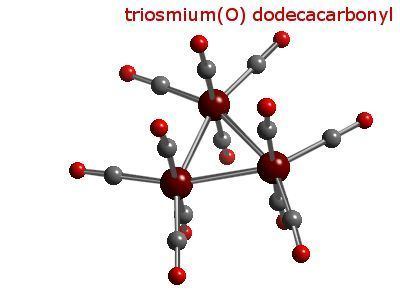Formula C12O12Os3 Density 3.48 g/cm³ Appearance yellow solid | Molar mass 906.81 g/mol Melting point 224 °C | |
 | ||
Related compounds | ||
Triosmium dodecacarbonyl is a chemical compound with the formula Os3(CO)12. This yellow-colored metal carbonyl cluster is an important precursor to organo-osmium compounds. Many of the advances in cluster chemistry have arisen from studies on derivatives of Os3(CO)12 and its lighter analogue Ru3(CO)12.
Contents
Structure and synthesis
The cluster has D3h symmetry, consisting of an equilateral triangle of Os atoms, each of which bears two axial and two equatorial CO ligands. The Os–Os bond distance is 2.88 Â (288 pm). Ru3(CO)12 has the same structure, whereas Fe3(CO)12 is different, with two bridging CO ligands resulting in C2v symmetry.
Os3(CO)12 is prepared by the direct reaction of OsO4 with carbon monoxide at 175 °C:
3 OsO4 + 24 CO → Os3(CO)12 + 12 CO2The yield is nearly quantitative.
Reactions
The chemical properties of Os3(CO)12 have been thoroughly examined. Direct reactions of ligands with the cluster often lead to complex product distributions because the inert Os–CO bonds require high temperatures to break, and at such high temperatures successive the initially formed adducts react further. More successfully, Os3(CO)12 is converted to more labile derivatives such as Os3(CO)11(MeCN) and Os3(CO)10(MeCN)2 using Me3NO as a decarbonylating agent. Os3(CO)11(MeCN) reacts with a variety of even weakly basic ligands to form adducts such as Os3(CO)11(ethylene) and Os3(CO)11(pyridine). The direct reaction of Os3(CO)12 with ethylene and pyridine results in degradation of these organic ligands to give the vinyl hydride HOs3(CO)10(η1,η2-C2H3) and the pyridyl-hydride HOs3(CO)10(NC5H4). These products illustrate the stability of Os–H and Os–C bonds.
Os3(CO)12 is a platform to examine the ways that hydrocarbons can interact with ensembles of metals. For example, the molecule CH3(H)Os3(CO)10 provided one of the first clear-cut examples of agostic bonding.
From the perspective of bonding, the molecule H2Os3(CO)10 is noteworthy. In this compound, the two hydride ligands bridge one Os-Os edge. The molecule displays reactivity reminiscent of diborane.
